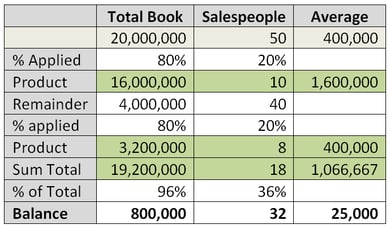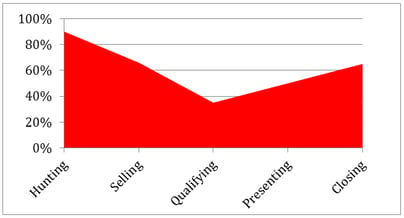In this blog post, we discuss the idea that prospects are like fruit and vegetables in the produce section of your local grocery – they are all perishable!
Prospects, like their produce counterparts, have a shelf life, and none of them will last forever. You must "eat" them, find a way to preserve them, or get rid of them!

Years ago, while attending the Objective Management Group International Sales Conference, Dave Kurlan, president of OMG, talked about how to effectively manage opportunities through the pipeline. He made the analogy that prospects are like fruit and vegetables in the produce section of your local grocery – they are all perishable.
That phrase has stuck with me all these years. We continue to reference it when we are presenting our Effective Sales System workshops and when working with our new clients for Hire Better Salespeople.
NOT EVERYONE HAS THE SAME "SHELF LIFE"
Prospects: They have a shelf life just like fruit: some of them a little longer than others.
Bananas – not so long.
Apples and mandarins – a little longer
Potatoes – not forever, but if they start to sprout, you can at least plant them in the ground and get more potatoes.
The bottom line is that none of them last forever. You need to either eat them or find a way to preserve them for later.
As you go about looking at the shelves (prospecting in the market) for the produce you need for tonight’s (or future) meal, you must be somewhat selective so that the food you select today, is fresh enough for cooking and consuming over a short period of time. I can buy a bag of potatoes and probably use them in two weeks. However, buy a bunch of bananas and we’ll need to eat them soon or else next week we will have to turn them into banana bread.
WHEN IT'S TIME, IT'S TIME
The same holds true for prospects relative to their buy cycle. They are not in that cycle forever. Depending on what services you sell, they could be off the shelf in a week. They may be in the looking, considering, “thinking about” cycle for a while, but once they decide to buy – it’s time to buy!
Years ago, I was in the market for a new vehicle. The Chevy Avalanche had been out for a couple of years and I knew, when the day came, that was going to be my purchase. There is a Chevy dealership just down the road from my house in Montgomery, Ohio, where I had purchased vehicles in the past from the manager Bill Wentzel.
When the day came, I went to Bill and told him I had a check in my pocket, and that I'd like to test drive the red Avalanche. I asked him if he would get me a salesperson who wouldn’t get in the way, and would just let me buy!
Two hours later (car sales take awhile), I drove off of the lot in my new shiny red Avalanche.
***Note to bankers, advisors and insurance salespeople***
Your prospects are ALWAYS in the market. EVERYONE you sell to is using, consuming and/or shopping for the services you offer. Your timing has to be good, but it doesn’t have to be great. What has to be GREAT is your constant contact with them so that, when they are ready, you are top of mind.
DON'T LET PROSPECTS PERISH
Here is my real point. When going out into the market, you can find yourself wasting your time with produce/prospects that aren’t quite ready, or are already past their "prime" time for consumption:
- Potatoes too green
- Bananas too green
- Tomatoes too yellow
- Peaches too mushy
- Stickers on meat packages that say “reduced”
- Just renewed my insurance
- Our lease expires in 11 months
- We have to wait until this election is over
If you want to close more business, more quickly at higher margins, then find the highly perishable prospects – work with them on solving their problem(s). Present a solution to them and get them off of the shelf. Do not neglect the potatoes, bananas, tomatoes or green beans; continue to check on them, plant them in your database (your CRM) and, when the time comes to make potato salad, they will be ready!
Additional Resources:
How Effective is Your Sales Process?
Do You Need Better “Shoppers” (salespeople) Who Won’t Perish? Sales Mistake Calculator
How to Determine a Qualified Prospect – Post-Call Checklist/Scorecard
Topics: Pipeline management, sales prospecting, closing sales

 Figure 1
Figure 1



